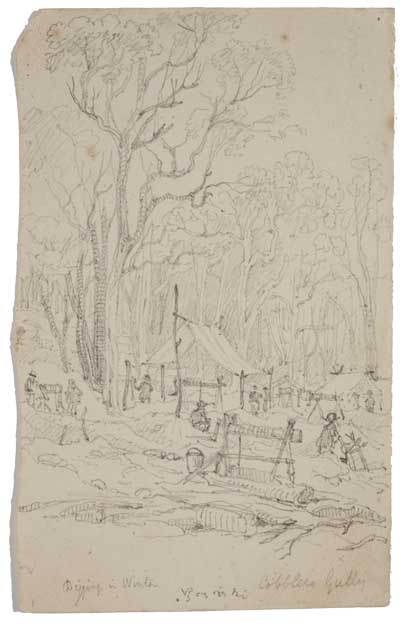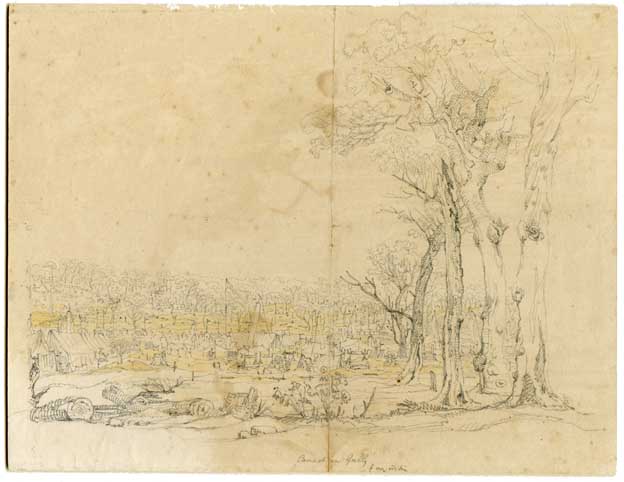Difference between revisions of "Henry Winkles"
| Line 3: | Line 3: | ||
==Background== | ==Background== | ||
| + | Printer, artist and engraver, Henry Winkles,came to the Ballarat goldfields in late 1852 to visit his son, who had recently moved into the area with his family. During Winkles’ stay in the region, he sketched the landscape between Ballarat and Buninyong, documenting the material existence of diggers in the early years of the gold rush. His fascination with the rough and contorted eucalypts of the region is also a recurrent theme.<ref>http://www.egold.net.au/biogs/EG00291b.htm, accessed 09/07/2013.</ref> | ||
| + | |||
| + | Having trained as a draughtsman in [[England]] and [[Germany]] before journeying to Australia, Winkles parallels [[Eugene von Guerard]], who was also at Ballarat in 1853. The work of these two contemporaries provides an interesting historical counterbalance. If Von Guérard's interpretations of Ballarat are stunning in their scope and their magnitude, Winkles’ sketches are equally so in their ability to capture the minute and the intimate.<ref>http://www.egold.net.au/biogs/EG00291b.htm, accessed 09/07/2013.</ref> | ||
==Goldfields Involvement, 1854== | ==Goldfields Involvement, 1854== | ||
| Line 8: | Line 11: | ||
==Post 1854 Experiences== | ==Post 1854 Experiences== | ||
| + | |||
| + | In 1854 Winkles returned to England where he pursued a successful career as book illustrator. He is best remembered for illustrating a popular series called The Cathedrals of England and Wales, which played an important role in the Gothic revival in Britain. <ref>http://www.egold.net.au/biogs/EG00291b.htm, accessed 09/07/2013.</ref> | ||
[[File:WINKLES Henry - Digging in winter - 2004.123-wiki.jpg|1000px|thumb|left|Henry Winkles, ''Digging in winter, Cobblers Gully,'' 1850s, pencil on paper. <br>Courtesy Art Gallery of Ballarat, Purchased with funds from the Colin Hicks Caldwell Bequest, 2004.]] | [[File:WINKLES Henry - Digging in winter - 2004.123-wiki.jpg|1000px|thumb|left|Henry Winkles, ''Digging in winter, Cobblers Gully,'' 1850s, pencil on paper. <br>Courtesy Art Gallery of Ballarat, Purchased with funds from the Colin Hicks Caldwell Bequest, 2004.]] | ||
Revision as of 11:13, 9 July 2013
Contents
Background
Printer, artist and engraver, Henry Winkles,came to the Ballarat goldfields in late 1852 to visit his son, who had recently moved into the area with his family. During Winkles’ stay in the region, he sketched the landscape between Ballarat and Buninyong, documenting the material existence of diggers in the early years of the gold rush. His fascination with the rough and contorted eucalypts of the region is also a recurrent theme.[1]
Having trained as a draughtsman in England and Germany before journeying to Australia, Winkles parallels Eugene von Guerard, who was also at Ballarat in 1853. The work of these two contemporaries provides an interesting historical counterbalance. If Von Guérard's interpretations of Ballarat are stunning in their scope and their magnitude, Winkles’ sketches are equally so in their ability to capture the minute and the intimate.[2]
Goldfields Involvement, 1854
Post 1854 Experiences
In 1854 Winkles returned to England where he pursued a successful career as book illustrator. He is best remembered for illustrating a popular series called The Cathedrals of England and Wales, which played an important role in the Gothic revival in Britain. [3]
See also
Further Reading
Corfield, J.,Wickham, D., & Gervasoni, C. The Eureka Encyclopaedia, Ballarat Heritage Services, 2004.
References
- ↑ http://www.egold.net.au/biogs/EG00291b.htm, accessed 09/07/2013.
- ↑ http://www.egold.net.au/biogs/EG00291b.htm, accessed 09/07/2013.
- ↑ http://www.egold.net.au/biogs/EG00291b.htm, accessed 09/07/2013.


